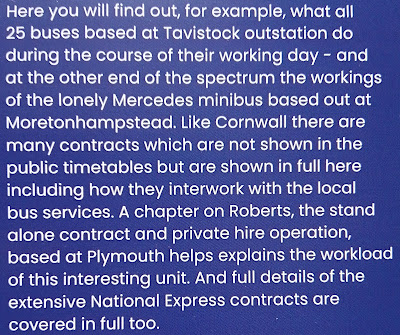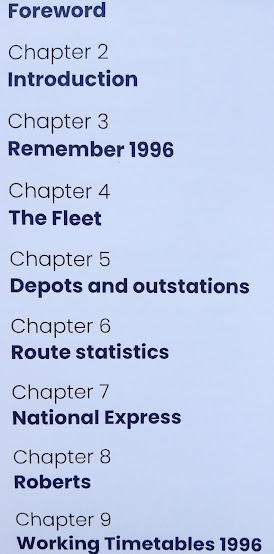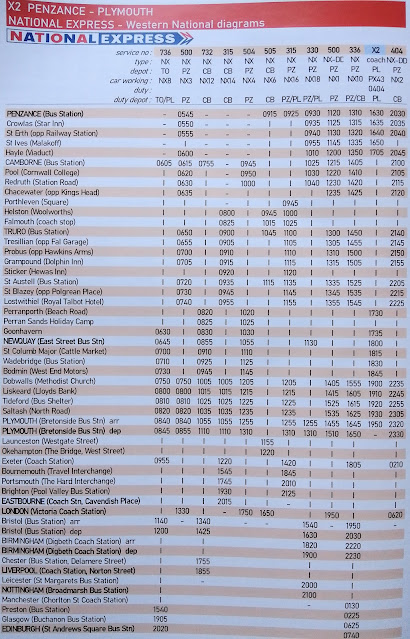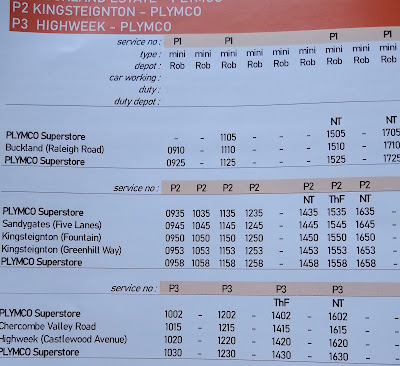And A Second Excitement In One Week**!
The above is the SIXTH book penned (laptopped?) by prolific Western National enthusiast Keith Shayshutt.
A review copy plopped through the letter bix at fbb mansions a few days ago. It is the second volume covering the working timetables of Western National as operated on 1st May 1996. To old blokes like fbb, 1996 seems quite recent, but it is over a quarter of a century ago! Yikes!
** The first excitement was the Exeter City timetable book.
But 1996 was, possibly, the peak of privatised Western National before purchase by First Bus, followed by a steady decline.
The scope of the book is well explained by a few on the back cover.You can often get the measure of the contents by looking at the chapter headings.Most are quite short but very informative with Chapter 9 being the bulk of the book.
As in Part 1 (The main Cornwall operation), the intro is from former WN general manager Mark Howarth, and this is followed by a few snippets to put 1996 into historical context; but nothing too heavy!Chapter 4 lists the fleet with well drawn side view pictures of each type of vehicle operated, all in the "diamond flag" livery adopted on privatisation. The buses are listed in detail by vehicle type and it is a revelation to see how many buses and coaches were in operation, in this case centred on Plymouth. Here, by way of a sample, is the list of 34 coaches.Of course there was a significant amount of work for National Express included here.
The fifth chapter deals with depots ...... some of which we might class as "outstations". A thumbnail sketch of each depot is part of the full table. Panels showing how vehicle were scheduled to "cycle" between depots are truly fascinating.
Chapter 6 is a list of "route statistics" which show the various levels of financial importance of each service., One intriguing column shows the change in percentage of receipts brought about by the arrival of tourists for the Summer season. These percentages are sometimes well over 1000! But we need to remember that an increase from one passenger a week to ten passengers a week is a 1000% growth - so not necessarily as important as the straight statistics may show.
Chapter 7 summarises the National Express commitment ....... with the main trunk coach timetables between Penzance, Plymouth and points east. and the "lesser" cross country workings appearing at the end of Chapter 9.
Chapter 8 is an eye-opener. WN bought the Roberts business in 1988 and by 1996 is was a stand alone contracts and school bus operation.Again, all the workings are tabulated in Chapter 9.
And so to he main thrust of this fascinating volume. Every scheduled operation, including schools and contracts, is given its detailed working timetable filling 90 of the book's 112 pages.
And what a fascinating resource it is.
fbb is well aware that the vast majority of bus enthusiasts are focussed on vehicles and their differences. But buses and coaches are built to carry passengers on journeys so this book explains how it was done. There is much, much more to bus operation than buying and maintaining a few tin boxes with seats riding on (usually) four or six wheels!
This book opens its pages to show what is involved in the day to day operation.
Have you ever heard of Tregadillet?Or you might consider a Friday afternoon round-trip to Buckland Monachorum.Then again maybe you might do some shopping at Plymco?
Or you might have done in 1996!
So, starting on Monday, fbb will take a closer look at a selection of these working timetables so see (a) where the buses actually went, (b) whether they still go there today, (c) how often they run today, and (d) which company operates them.
It won't be First Bus, that is certain!
If you have any interest in bus operation, or have a hankering for the delights of Western National's extensive territory in 1996, this is a book for you.
At £18 (available on EBay) this book is a must-have. fbb recommends!
A Geographical P.S.
Tregadillet (old map bottom left) is just along the A30 west from Launceston ...
Buckland Monachorum (below, centre left) is near Yelverton ...
Plymco was the "brand" used by Plymouh Co-op for its retail stores.Clever name, eh?
... but today there is a dual carriageway super road by-passing the village.
... and you may have an immature schoolboy snigger at nearby Crapstone! Can't think why.
Next Variety blog : Saturday 11th February

















An increase from 1 to 10 passengers is a 900% increase (start with what 1 to 2 is and work it out). A school mate once had a letter published in The Times highlighting a contemporary speech by Mrs Thatcher which fell into the same trap.
ReplyDelete